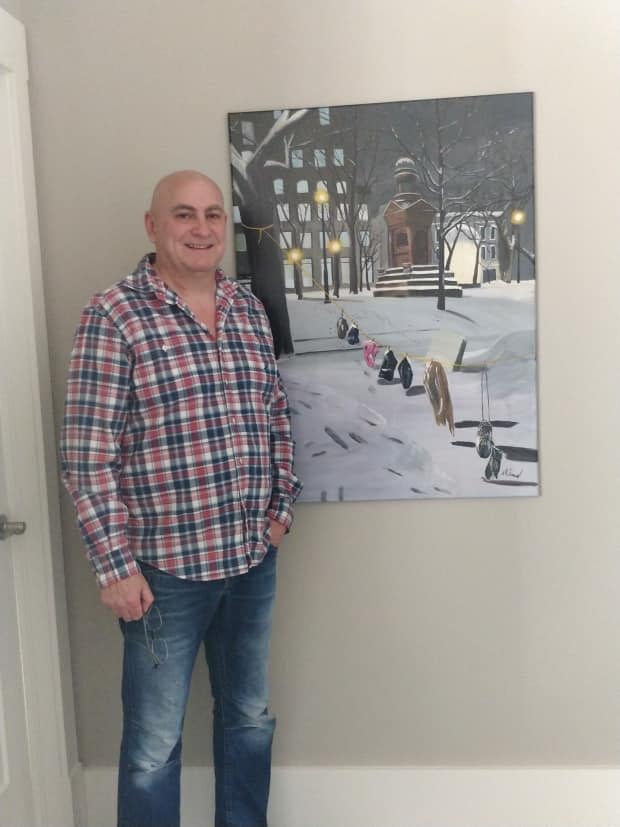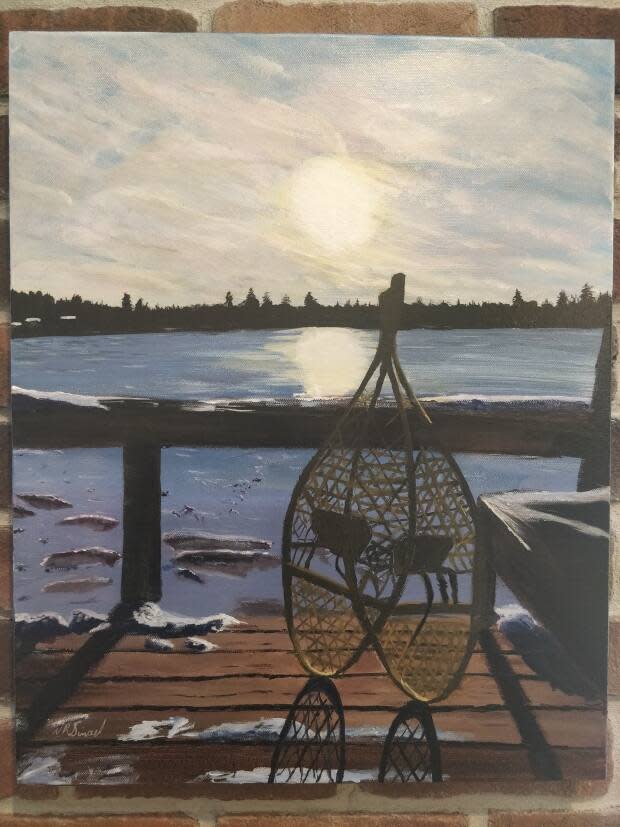Rothesay man with Lyme-related brain impairment discovers hidden talent for painting

A 57-year-old Rothesay man who only took up painting about a year ago is thrilled that two of his pictures have made it into an international exhibit, sponsored by the Society of Canadian Artists.
Norman Simard's works titled Mittens and Winter Stroll are among 157 pieces of art chosen from 666 entries in the 2021 Open International Online Juried Exhibition.
The novice painter has even more cause to celebrate the achievement because he did it in the face of severe physical and cognitive problems, believed to be the result of Lyme disease.
Simard got into painting last spring, on a whim.
He was watching YouTube on his tablet when he came across a 10-minute time-lapse video of a man painting with a palette knife.
"I looked at my wife, I put the tablet down and I said, 'OK, I want to go buy some painting supplies. I want to paint."

Simard hadn't attempted anything artistic since the 10th grade, when repeated comparisons to his twin brother's artistic prowess prompted him to drop out of art class after just a couple of weeks.
"Probably the worst thing you could do to a twin," he said.
"I was trying to be my own person."
(His brother didn't end up pursuing art either, but he did finish the class.)
For the next 40 years, Simard had no desire to make art, until he watched that video two days before the start of a COVID "lockdown."
He and his wife, Rachel, picked up some canvases, brushes and paint and Norman attempted to reproduce a screenshot he'd taken from the video.
He had no idea what he was doing.
He didn't know how to apply the paint or even mix the colours.
He used a lot of paint trying to make the colour brown.
He might have saved some by using his colour wheel, but because he has short-term memory problems, he kept forgetting that he had one, even though it was right there in front of him.
"A lot of times I would be kind of in my foggy Lyme brain, because I was still pretty foggy back then."
"I'd just get into that haze of painting."

He was surprised at how well his first painting turned out in the end — "so nice that my wife has it hanging on the wall."
Rachel Simard is proud of how far her husband has come.
She retired early from her full-time government job to be with her husband after he became ill.
But Norm did a lot of fighting on his own, she said, while not knowing what was happening to him, to get to where he is today.
First symptoms of Lyme disease
He started having health problems in the fall of 2017.
The first thing he noticed was that the soles of his feet were sore when he got up in the morning.
That went away.
Then one day he got home from work and noticed his arm was getting numb. The next morning it was worse, and the numbness had spread to his leg and the left side of his face wouldn't move.
Doctors ruled out a stroke and advised him to go home and "take it easy."
Simard said he started having heart palpitations in January 2018. Doctors again told him it seemed like stress. He was starting to feel like they thought he was a hypochondriac.

In May 2018, he was out in the yard taking down a fence used to protect some cedars from snow and deer when he became very dizzy.
"The world just started spinning. I couldn't stand. I just sort of staggered to the side of the garage and slumped against the house."
On the way to the hospital he lost the ability to speak.
"I just felt like I was in a big, grey box."
He was sent for a CT scan and other tests. Doctors thought it was an atypical migraine.
His condition continued to worsen.
"It was sort of like someone had put a big metal band around my head and was tightening a vise."
That feeling of heavy pressure continued for months.
Norm had trouble staying awake. Speech was slow and difficult.
He saw a number of specialists, but nothing really helped.

Eventually, he was told to return to work at Irving Paper, although he found it difficult to do his job. He'd forget things and couldn't think ahead.
That was problematic for a technical guy. Simard worked in the instrumentation and electrical department.
Before he went to Irving Paper, he worked at the Lepreau generating station, on frigates, and on jets in the air force.
But back on the job, Simard finally connected with someone who had seen symptoms similar to his, caused by Lyme disease. A co-workers had a daughter who'd had Lyme.
She had had a telltale bull's-eye rash, however, and received treatment within a week or two.
Simard had been given an antibody test for Lyme that had come back negative.
But he recalled that he'd found a tick while taking a shower in September 2017, two months before he started noticing symptoms.
He'd had a rash shortly after, too, on his chest. But it wasn't a bull's-eye.
Too late to treat
He discovered a list of Lyme disease symptoms on the government of Canada website that he says matched everything he'd been experiencing.
He sought another medical opinion. This time, he said, the doctor told him he likely had Lyme disease, but it was probably too late to treat it.
Still, the two weeks of antibiotics she prescribed brought him, "from a really bad state to somewhere where I could partially function."
He then saw a Lyme disease specialist in Maine, who diagnosed him in the fall of 2018, about a year after he'd started having symptoms.
Different tests and treatments are available in Maine, for a price. It was $500 for the test and every time he went for an in-person appointment it cost about $1,500.
Simard considers it "money well spent."
"I was turning into a vegetable with a lot of physical conditions," he said.
Once he started treatment, which included more time on antibiotics, there was a "noticeable turnaround."
Now he can walk almost normally and he no longer finds it overwhelming to be in the same room with more than a few other people.
Considering where I could've been, I'm pretty happy." - Norman Simard
He has an appointment with his doctor in Maine every three or four months. They've been remote appointments during the pandemic.
"He seems to think I'm as good as I'm going to get now," said Norm.
Wednesday was the first "really bad day" he'd had in a while. He couldn't do anything but sit in a chair with the TV on and his eyes closed.
Norm said he gets extremely tired when he exerts himself in any way and then his short-term memory gets bad and he gets confused.
"If I have to recall memories or solve puzzles or life puzzles — just everyday stuff — that can be a bit of a drain."
At 11:50 he can say he's going to make Rachel an omelette for lunch, and by noon, he'll have forgotten all about it.
"A lot of people would probably cry about being stuck at the state I'm at," said Norm, "but considering where I could've been, I'm pretty happy."
He tries to paint for a couple of hours every day, about as long as he can handle.
Then he stops and takes stock of what he's done and says, "Huh, look at that!"
It's getting easier to remember what colours mix to create other colours, he said, and he's getting quicker at painting.
The first painting was small and took a couple of weeks. His recent ones have taken about three weeks but are larger and have more detail.
"I spend a lot of time making the skies look the way they do. There's a lot of back layers that give you those effects."

Sometimes he finds it looks like more of a mess than art.
But he keeps painting layer upon layer until the colours and shading and details look right.
He's made 22 paintings now.
Most of them have been realist landscapes, but he's also done some abstract pieces.
He tries to use a palette knife for most of his work.
He's still not really sure how he does it.
"I have a hard time believing that this art is something I painted."
Norm has sold most of his paintings. Two or three went for $1,200 each, he said.
He found out about the art competition from a post on the Saint John Art Club Facebook page.
"I was just finishing a painting and thought I should do it just for exposure," he said.
"I felt it was good and I had been told by many people that my paintings were nice. I figured it'd just be kind of cool to apply."
He sent in his entry and "kind of forgot about it," until he got a congratulatory email.
"I thought wow that's pretty cool. If you look at that website, there are some amazing artists in there."
"I think to have made it into that level of art is probably a feather in your hat to feel pretty proud of."
His favourite painting is always his most recent one.
"When I'm done them there's quite a sense of satisfaction."
He just finished one of St. Martins that he thinks turned out "really nice."
It's based on a photograph that a friend took from "a unique angle" on the shoreline.
In the foreground there's an eroded stack of earth skirted by a thick bed of seaweed. In the background, there are pools of water, boats at the wharf, a covered bridge and brightly coloured buildings.
Norm said he exaggerated the brightness of the colours to look like something typical of the coast of Newfoundland.
The sun is peeking out and the colours are more vibrant where the light touches.
"Everybody keeps telling me how beautiful it is," he said.
Norm finds comments like that very encouraging and plans to keep painting.
"To me art somehow should make people happy."
He thinks he has something a little different to offer.
Another thing he hears often is that the colours and depth come across much better in person.
That's why he'd love to get one of his paintings in an art gallery.
For now, he shares his work on Facebook under the name NRSimardsart.

 Yahoo Movies
Yahoo Movies 